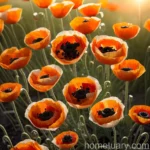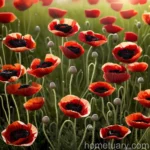The Allure of Icelandic Poppy (Papaver nudicaule ‘Champagne Bubbles Scarlet’)
In the world of botany, few flowers can match the charm and captivating beauty of the Icelandic poppy (Papaver nudicaule ‘Champagne Bubbles Scarlet’). This delightful flower, with its delicate petals and vibrant colors, has enamored gardeners, florists, and nature enthusiasts for centuries. In this comprehensive guide, we will explore everything there is to know about the incredible Icelandic poppy – from its cultural significance to its propagation, care tips, common pests, and much more.
What is the Icelandic Poppy (Papaver nudicaule ‘Champagne Bubbles Scarlet’)?
The Icelandic poppy, scientifically known as Papaver nudicaule ‘Champagne Bubbles Scarlet’, is a charming perennial plant belonging to the Papaveraceae family. Originating from the subpolar regions of Europe, Asia, and North America, this poppy species is renowned for its captivating and brightly colored flowers. The ‘Champagne Bubbles Scarlet’ variety specifically boasts striking scarlet blooms, adding a bold and lively touch to any garden or floral arrangement.
Key Takeaways – Icelandic Poppy (Papaver nudicaule ‘Champagne Bubbles Scarlet’)
Before delving into the various aspects of caring for Icelandic poppies, let’s summarize the key takeaways about this enchanting plant.
- Cultural Significance: Loved for its vibrant flowers, the Icelandic poppy holds cultural and symbolic significance in various traditions and folklore.
- Use Cases: Widely used in landscaping, floral arrangements, and even traditional medicine, the Icelandic poppy offers versatility and practical applications.
- Care Requirements: Proper watering, sunlight, soil quality, and fertilization are crucial for nurturing healthy Icelandic poppy plants.
- Propagation Methods: Icelandic poppies can be propagated from seeds or through division, offering options for both beginners and experienced gardeners.
- Common Pests and Diseases: Understanding and addressing potential pest and disease issues is essential for maintaining the health of Icelandic poppies.
Culture
Uses
The beautiful and enchanting flowers of the Icelandic poppy make it an ideal choice for a variety of uses, including:
- Landscaping: Icelandic poppies are commonly used to add vibrant and eye-catching colors to garden beds, borders, and rock gardens. They can also be interplanted with other perennials to create stunning floral displays.
- Floral Arrangements: Due to their striking beauty and variety of colors, Icelandic poppies are popular choices for floral arrangements, adding a touch of elegance to bouquets and centerpieces.
- Traditional Medicine: In some traditional medicinal practices, parts of the Icelandic poppy have been used for their potential therapeutic properties. Caution should be exercised, however, as the plant contains alkaloids that can be toxic if ingested in large quantities.
- Symbolism: With its delicate and alluring appearance, the Icelandic poppy has been associated with various symbolic meanings, often representing imagination, enchantment, and success.
Care
In order to ensure the optimal growth and blooming of Icelandic poppies, it is imperative to provide appropriate care and maintenance. The following factors are crucial for the well-being of these charming plants:
Water
Proper watering is essential for the health and vigor of Icelandic poppies. As a general rule, it is advisable to water the plants deeply and less frequently, allowing the soil to dry out slightly between watering sessions. Avoid overwatering, as excessive moisture can lead to root rot and other moisture-related issues.
Sunlight
Icelandic poppies thrive in bright, indirect sunlight with some dappled shade. In hot climates, they benefit from partial shade during the hottest part of the day. Adequate sunlight is crucial for the development of robust plants and abundant flower production.
Fertilizer
Regular fertilization is key to supporting the growth and blooming of Icelandic poppies. A balanced, all-purpose fertilizer, applied according to the manufacturer’s instructions, can help promote healthy foliage and vibrant flowers. It is advisable to fertilize the plants in early spring and then again after the first bloom to support continuous flowering.
Soil
Well-draining, fertile soil is optimal for Icelandic poppies. A slightly acidic to neutral pH range is preferred. Amending the soil with organic matter, such as compost or well-aged manure, enhances its fertility and texture, creating a favorable environment for the growth of healthy plants.
Pruning
Deadhead faded flowers regularly to prolong the blooming period and encourage the development of new blooms. Additionally, removing spent flowers prevents the plants from expending unnecessary energy on seed production, redirecting their resources towards further flowering.
Propagation
Propagating Icelandic poppies can be achieved through two primary methods: seeds and division. Both methods have their respective advantages and can be employed based on individual preferences and requirements.
- Seeds: Icelandic poppies can be grown from seeds, which are usually sown directly into the garden bed or containers in early spring or fall. The seeds should be lightly covered with soil and kept consistently moist until germination occurs.
- Division: Established Icelandic poppy plants can be divided in early spring or early fall. Carefully lift the plants and separate the clumps into smaller sections, each containing healthy roots and shoots. Replant the divisions at the appropriate spacing, taking care to provide adequate water and follow-up care.
Container Popularity
Icelandic poppies are well-suited for container cultivation, offering an excellent option for those with limited space or for individuals looking to bring a touch of elegance to their patios, balconies, or indoor spaces. When grown in containers, Icelandic poppies can be placed strategically to add vibrant splashes of color and natural beauty to any setting.
Common Diseases
While Icelandic poppies are relatively low-maintenance plants, they can be susceptible to certain diseases and issues that can impact their health and vigor. Understanding these common diseases and their associated symptoms is essential for proactive and effective management.
Disease Diagnosis
Some of the common diseases that can affect Icelandic poppies include:
- Powdery Mildew: This fungal disease presents as a white, powdery coating on the leaves, stems, and flowers of the plants. It thrives in humid conditions and can weaken the plants if left unchecked.
- Root Rot: Excessive moisture, especially in poorly draining soil, can lead to root rot. Affected plants may exhibit wilting, yellowing foliage, and stunted growth.
- Downy Mildew: Similar to powdery mildew, downy mildew is a fungal disease that appears as grayish downy growth on the lower surfaces of the leaves. It can lead to leaf distortion and overall decline of the plants.
Common Pests
In addition to diseases, Icelandic poppies can also fall prey to various pests that can impact their growth and bloom production. Vigilance and early intervention are key in managing these common pests effectively.
Botanist’s Tips
As a plant scientist with a passion for Icelandic poppies, I have learned several valuable tips that can help enthusiasts cultivate and care for these captivating plants:
- Provide Adequate Air Circulation: Ensuring good air circulation around Icelandic poppies can help minimize the risk of fungal diseases and pest infestations. Proper spacing and strategic placement can contribute to healthier plants overall.
- Mulch for Moisture Regulation: Applying a layer of organic mulch around Icelandic poppies helps regulate soil moisture, reduce weed competition, and contribute to overall soil health. Avoid placing mulch directly against the plant stems to prevent potential issues.
- Monitor for Pests and Diseases: Regular inspections of the plants for signs of pests or diseases enable early detection and intervention, preventing potential issues from escalating and causing significant damage.
Fun Facts
- The Icelandic poppy is not native to Iceland, despite its name. It was likely introduced to Iceland by early settlers or through natural dispersal mechanisms.
- The botanical name “Papaver” is derived from the Latin word for “poppy,” highlighting the historical and cultural significance of this diverse plant genus.
- Icelandic poppies are renowned for their ability to attract pollinators, such as bees and butterflies, making them valuable contributors to the ecosystem.
Links to External Resources
For further exploration of Icelandic poppies and related topics, the following external resources provide valuable insights and information:
- Royal Horticultural Society – Papaver nudicaule
- American Society for the Prevention of Cruelty to Animals – Toxic and Non-Toxic Plants: Iceland Poppy
Conclusion
In conclusion, the Icelandic poppy (Papaver nudicaule ‘Champagne Bubbles Scarlet’) is an extraordinary plant that embodies beauty, versatility, and cultural significance. From its striking scarlet flowers to its adaptability in various settings, this captivating poppy has captured the hearts of gardeners, artists, and nature enthusiasts around the world. By understanding and implementing the appropriate care, maintenance, and precautionary measures, individuals can enjoy the perennial allure and charm of these enchanting flowers, while contributing to their longevity and vibrancy. As with any aspect of horticulture, learning about the unique characteristics, care requirements, and potential challenges of Icelandic poppies enriches the experience of cultivating and appreciating these extraordinary plants.















